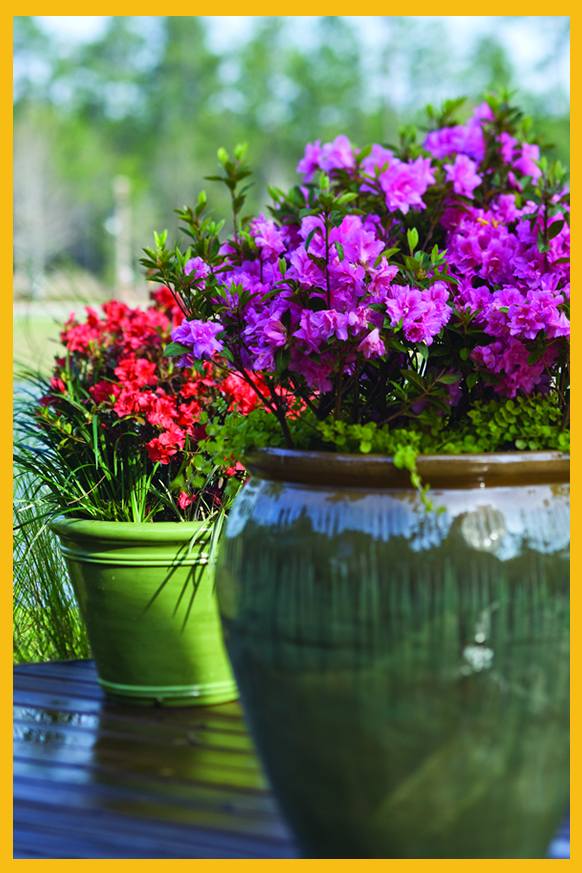Q: I am planting Azaleas in pots this fall, but my Azalea's leaves are turning yellow. What is wrong?
A: Let me share with you some tips for keeping Azaleas happy and then you can determine if you need to make changes in the care you are giving your plants. Azaleas are plants that do well in acidic, well-draining soil that is high in organic matter. They require regular water. Do not allow them to dry out. They do best in morning sun only or dappled shade. Looking at your photo, I would say either your plant may be in too much sun, the soil may not be draining well, and/or the soil may not be acidic enough.
 In San Diego, the soils tend to be alkaline. Azaleas that are in soil that is too alkaline commonly develop yellow leaves because iron is not available to them at a high pH. Also, if you fertilize with a typical fertilizer the nitrogen source is wrong and toxic for Azaleas. Common synthetic fertilizers have nitrogen in the form of nitrate nitrogen (NO3). Azaleas need nitrogen in the ammonium form (NH4) rather than the more common nitrate nitrogen. Most typical fertilizers are toxic to azaleas. Buy fertilizer labeled for "Acid-Loving" plants. These will have ammonium nitrate. You need a fertilizer with ammonium nitrate or, better yet, feed with just regular applications of organic material that break down and feed the plant.
In San Diego, the soils tend to be alkaline. Azaleas that are in soil that is too alkaline commonly develop yellow leaves because iron is not available to them at a high pH. Also, if you fertilize with a typical fertilizer the nitrogen source is wrong and toxic for Azaleas. Common synthetic fertilizers have nitrogen in the form of nitrate nitrogen (NO3). Azaleas need nitrogen in the ammonium form (NH4) rather than the more common nitrate nitrogen. Most typical fertilizers are toxic to azaleas. Buy fertilizer labeled for "Acid-Loving" plants. These will have ammonium nitrate. You need a fertilizer with ammonium nitrate or, better yet, feed with just regular applications of organic material that break down and feed the plant.
Azaleas (and other members of the Ericaceae Family) actually do better without synthetic fertilizer. Plants in the Ericaceae are frequently found in hostile environments of low fertility and low pH. Just the breakdown of decomposing mulch provides the nutrition that these plants need. I realize, though, that your plants are in pots and that may present a challenge to providing enough soil nutrients. Ideally, Azaleas would be in the mulched ground, and they would develop a relationship with existing mycorrhizal fungi. Because of the harsh environmental conditions found where ericaceous plants grow they have evolved to be dependent on at least three types of mycorrhizae. The fungi secure nutrients for the ericaceous plant in exchange for carbon. Synthetic fertilizers disassociate this relationship making the plant reliant on regular additions of these fertilizers. It is much better to have the plant develop these mycorrhizal relationships than to be addicted to synthetic fertilizer. Your plants will be healthier as a result.
Once again, San Diego's native soil is alkaline as opposed to acidic, and our water is also highly alkaline. The soil pH in San Diego is around 7, your Azalea would like pH that is much lower, 4.5-6. So what do you do? You can purchase soil for "acid-loving" plants. Use this for your planting soil in the pot. Don't put gravel or anything else in the pot as it will compromise drainage. Even so, with time this potting mix will go alkaline from repeated irrigation with alkaline water. To keep that from happening make yearly, or twice-yearly applications of soil sulfur to counteract the alkalinity. E.B. Stone also has Soil Sulfur. Good garden centers will have both of these.
I would think about getting a deeper pot and also mulching the soil surface when you are done planting, with tree bark or other organic material. Make sure there is at least 2-3 inches of space at the top of the pot when you add your soil. Organic material breaks down with time and azaleas really benefit from this. Organic material tends to mediate the soil pH as well as feed the plant. Azaleas, Blueberries, and Rhododendrons are Ericaceous plants, and as such, have fine surface root hairs where the relationship with mycorrhizal symbionts is formed. In their native environment, they often form extensive fungal relationships that protect the plant. To protect these fine roots, I recommend mulching regularly or because they are in pots, using an organic "acid-lovers" fertilizer. Options should be readily available at your local big-box store. The unique fine surface root hairs of Azalea are very sensitive and dry out easily. Mulch does two things, it feeds the plant when it breaks down, and it keeps moisture around the roots.
I hope you didn't mind this long explanation. I just wanted to give you some information about Azaleas and how they are different than most plants we grow here in San Diego. In summary, use an acid-lovers soil to pot this plant, place in morning sun or partly shaded location, water regularly and don't allow them to dry out, mulch and add soil acidifier once or twice a year. This should get your Azaleas green again and growing great!
Sharon Reeve has been a UCCE Master Gardener since 2012

